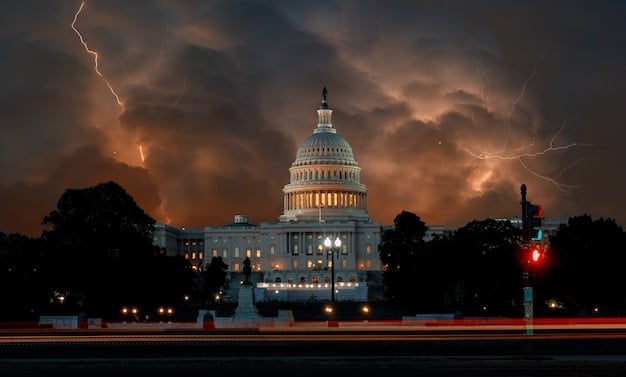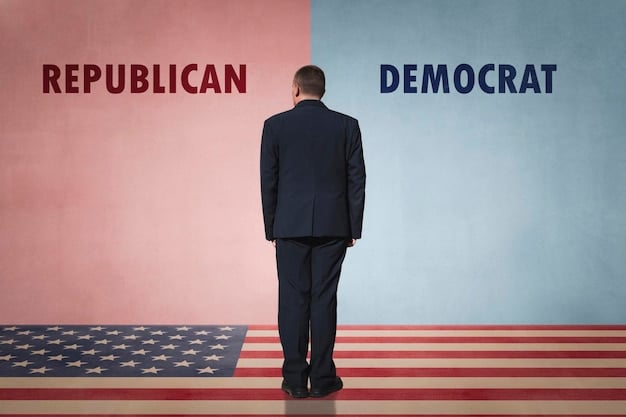Breaking: Congress Reaches Last-Minute Deal to Avert Debt Ceiling Crisis

A last-minute agreement has been reached in Congress to suspend the debt ceiling, preventing a looming economic crisis in the United States and setting the stage for upcoming budget negotiations.
In a dramatic turn of events, Congress has reached a bipartisan agreement to suspend the **Breaking: National Debt Ceiling Crisis Averted – Last-Minute Deal Reached in Congress**, staving off what many feared would be a catastrophic economic downturn.
Breakdown of the Debt Ceiling Agreement
The agreement to suspend the debt ceiling marks a pivotal moment in American politics. Understanding the specifics of this deal is crucial for gauging its potential impact on the nation’s economy and future fiscal policy.
Key Provisions of the Deal
The agreement outlines several important provisions designed to address the immediate crisis and set the stage for future fiscal responsibility. These provisions include spending caps, discretionary spending adjustments, and measures to accelerate certain energy project approvals and other regulatory reforms. Each of these components has been carefully negotiated to balance competing priorities and ensure bipartisan support.
- Spending Caps: Establishes caps on discretionary spending for the next two fiscal years.
- Discretionary Spending Adjustments: Limits growth in discretionary spending.
- Energy Project Approvals: Expedites the approval process for certain energy projects.
- Regulatory Reforms: Includes measures aimed at streamlining regulations.

These provisions collectively aim to provide short-term stability and encourage long-term fiscal health. The details of each provision will continue to be debated and scrutinized as the agreement moves forward, but their inclusion represents a significant step towards addressing the debt ceiling crisis.
In summary, the debt ceiling agreement includes provisions such as spending caps and discretionary spending adjustments that were key to reaching a compromise and preventing financial turmoil in the US economy.
Political Reactions to the Agreement
Following the announcement of the debt ceiling agreement, reactions from both sides of the political aisle varied widely. Understanding these reactions provides insight into the challenges and compromises that shaped the deal.
Democratic Perspectives
Many Democrats have expressed cautious optimism about the agreement, emphasizing the importance of averting a potential economic catastrophe. While some acknowledge that the deal includes compromises they would not have preferred, they generally view it as a necessary step to protect the nation’s financial stability.
Republican Perspectives
Republicans have offered a more divided response, with some praising the agreement for its spending cuts and others criticizing it for not going far enough to address the national debt. The debate within the Republican Party reflects the ongoing tension between fiscal conservatism and the desire to avoid a default on the nation’s obligations.
- Cautious Optimism: Democrats largely see the deal as a necessary compromise.
- Divided Response: Republicans are split on whether the deal achieves sufficient spending cuts.
- Future Negotiations: Both parties acknowledge that further negotiations will be needed to address long-term fiscal challenges.
The political reactions to the agreement are a testament to the complex challenges of governing in a divided nation. As the deal moves forward, it will be important to continue monitoring the perspectives of both parties and the potential impact on future negotiations.
In conclusion, the debt ceiling agreement has elicited a mixed bag of reactions from Democrats and Republicans, highlighting deep divisions, yet also demonstrating the necessity of bipartisan cooperation to address high-stakes economic challenges.
Economic Impact of the Deal
The debt ceiling agreement is expected to have far-reaching effects on the U.S. economy. Economists and financial analysts are closely examining the potential implications of the deal on various sectors and indicators.

Short-Term Effects
In the short term, the agreement is expected to stabilize financial markets and boost investor confidence. By removing the immediate threat of a default, the deal provides a sense of certainty and allows businesses to move forward with their investment plans.
Long-Term Effects
The long-term economic effects of the agreement are more uncertain. While the spending caps and discretionary spending adjustments may help to reduce the national debt over time, they could also dampen economic growth by limiting government investment in key areas such as infrastructure and education.
The debt ceiling agreement is an important step in promoting financial stability, the long-term effects on growth and debt reduction remain to be seen, as well as the continued monitoring of economic indicators that will be critical.
Understanding the National Debt
The national debt is a critical issue that warrants careful consideration. To fully appreciate the significance of the debt ceiling agreement, it is essential to understand the current state of the national debt and its potential consequences.
Current Debt Levels
The United States currently has a substantial national debt, which is the accumulation of past budget deficits. This debt is held by a variety of entities, including individuals, corporations, and foreign governments. The sheer size of the debt raises concerns about its sustainability and potential impact on future generations.
Consequences of High Debt
High levels of national debt can have a number of negative consequences. These include higher interest rates, reduced investment, and increased vulnerability to economic shocks. In addition, a high debt burden can limit the government’s ability to respond to future crises and invest in important programs.
- Sustainability Concerns: The current debt level raises concerns about long-term sustainability.
- Negative Consequences: High debt can lead to higher interest rates and reduced investment.
- Limiting Future Flexibility: A high debt burden can limit the government’s ability to respond to future crises.
Understanding the national debt is crucial for making informed decisions about fiscal policy. By addressing the debt and promoting fiscal responsibility, the United States can help to ensure a brighter economic future for all.
The national debt is a pressing problem that requires sustainable and comprehensive solutions, since the implications of a high national debt can have impacts on investment, interest rates, and a government’s flexibility to respond to various crises.
The Role of Bipartisanship
The debt ceiling agreement highlights the importance of bipartisanship in addressing the nation’s challenges. Reaching a compromise that can garner support from both parties is essential for effective governance and long-term stability.
Finding Common Ground
Bipartisanship requires a willingness to find common ground and make concessions. In the case of the debt ceiling agreement, both Democrats and Republicans had to set aside some of their priorities in order to reach a deal that could pass through Congress. This willingness to compromise is a hallmark of effective leadership.
Benefits of Collaboration
Collaboration between parties can lead to more durable and sustainable solutions. By incorporating the perspectives of both Democrats and Republicans, the debt ceiling agreement is more likely to withstand the test of time and achieve its intended goals.
In order to ensure effective governance and long-term stability, working together and making compromises are vital, as proved possible by the recent debt ceiling agreement.
Future Fiscal Challenges
While the debt ceiling agreement addresses the immediate crisis, it does not solve the nation’s long-term fiscal challenges. A number of significant issues remain that will need to be addressed in the coming years.
Entitlement Reform
One of the biggest challenges facing the United States is the long-term sustainability of entitlement programs such as Social Security and Medicare. These programs are projected to face significant funding shortfalls in the coming decades as the population ages and healthcare costs continue to rise. Addressing these shortfalls will require difficult choices and potentially unpopular reforms.
Tax Policy
Tax policy is another area that will need to be carefully considered in the years ahead. The current tax code is complex and inefficient, and many believe that it needs to be reformed to promote economic growth and fairness. However, any changes to the tax code are likely to be met with strong opposition from various interest groups. These groups include businesses, individuals, and foreign governments that all have their own interests, but also have an impact on economic growth.
- Entitlement Reform: Significant reforms needed to ensure long-term sustainability of programs.
- Tax Policy: Requires careful consideration to promote efficiency, growth, and fairness.
- Budget Priorities: Ongoing debates over how best to allocate resources.
The debt ceiling agreement serves as a reminder of the importance of addressing the nation’s fiscal challenges in a responsible and sustainable way. By being aware of these challenges and working together to find solutions, the United States can help to ensure a brighter economic future for all.
Though the recent debt ceiling agreement has solved some issues, the nation must work together in a responsible manner to handle pressing tax policies and major entitlement changes needed in the years to come.
| Key Point | Brief Description |
|---|---|
| 🤝 Bipartisan Agreement | Congress reached a deal to suspend the debt ceiling. |
| 💰 Spending Caps | The deal sets caps on discretionary spending. |
| 📈 Economic Impact | Stabilizes markets; long-term effects uncertain. |
| 🧾 Future Challenges | Entitlement and tax policy reforms needed. |
Frequently Asked Questions
▼
The debt ceiling is a legal limit on the total amount of money the U.S. government can borrow to meet its existing legal obligations. These obligations include Social Security, Medicare benefits, military salaries, interest on the national debt, tax refunds, and other payments.
▼
If the debt ceiling is not raised or suspended, the U.S. government would be unable to pay its legal obligations, leading to a potential default. This could result in a stock market crash, higher interest rates, and a recession, damaging the nation’s economy.
▼
The debt ceiling agreement primarily suspends the debt ceiling until January 1, 2025, allowing the government to continue borrowing to meet its obligations. It also includes provisions for spending caps and discretionary spending adjustments to curb future debt increases.
▼
Stock market generally reacted positively to the agreement, due to the immediate threat of default being averted when an agreement on raising or suspending the debt ceiling was reached. It also instilled confidence in investors and businesses.
▼
The long-term implications of the agreement are still uncertain. The spending caps and adjustments could lead to decreased government investments, which in turn may slow down economic growth. Also, future debates over longer-term debt management are inevitable.
Conclusion
In conclusion, the debt ceiling agreement represents a critical step in averting an immediate economic crisis and ensuring the stability of financial markets. While the agreement includes compromises and difficult decisions, it demonstrates the importance of bipartisanship in addressing the nation’s challenges and preventing default. While it does address the underlying issues, it should be viewed as a temporary solution.





